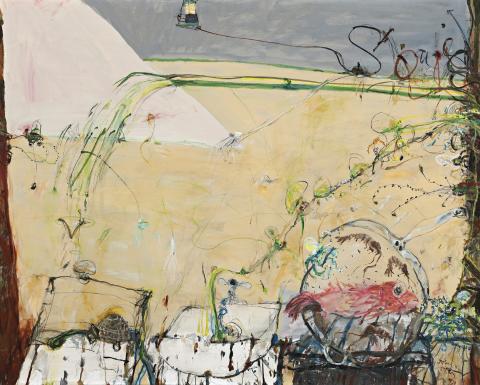KITCHEN STORY, 1993
JOHN OLSEN
oil on canvas
121.0 x 151.0 cm
signed and dated lower right: John Olsen / 93
signed, dated and inscribed with title verso on stretcher bar: John Olsen / - 93 / KITCHEN STORY / KITCHEN STORY
Sherman Galleries, Sydney (label attached verso)
Gene and Brian Sherman collection, Sydney
John Olsen: Recent Work, Sherman Galleries, Sydney, 28 October – 20 November 1993
Cuisine & Country: a gastronomic venture in Australian art, Orange Regional Gallery, NSW, 13 April - 20 May 2007, and touring regional galleries in New South Wales and Queensland from June 2007 - October 2008
In many ways, Olsen’s life and his art are inseparable. His oeuvre represents the cumulative response of an artist intoxicated with the landscape, its people and their attitudes towards food, life and art. The artist’s dedication to the good life is legendary, and this along with his love of poetry has inspired much of the artist’s work. In fact, over many years the artist has been known to create entire exhibitions on the theme of food and cooking.
In her monograph on the artist in 1991, Deborah Hart revealed that it was necessity that introduced Olsen to the world of fine food: ‘In Ibiza and Deya, Olsen worked for brief periods as an apprentice chef. Before he left Australia he was hard pressed to boil an egg; by the time he returned he had developed a great admiration for Mediterranean attitudes to food and wine – the joy of preparing and sharing meals with feeling – which, even when enjoying the simplest ingredients, had the potential to add to the richness and celebration of life. This sensibility would remain with him always, and the subject of food, and paella in particular, would recur in his later paintings and drawings’.1
Olsen infuses his paintings with a life beyond the literal. They do not simply present an event as a static image, but as a rollicking yarn which unravels across the painting’s surface in great detail. Olsen’s Kitchen Story, 1993, is a cacophony of activity, in which the artist’s characteristic repertoire of marks are present in this celebratory painting. The lower right quarter of the painting for example clearly depicts the main ingredients; the luscious red fish provides a burst of high colour and scale which activates the entire composition. The fish, prawns and frying pan allow Olsen to flex his ability as a draughtsman as his wristy calligraphic brush marks find a delicate balance between illustration and expression.
As with most Olsen paintings, the line is central to the artist’s language as it forms the arteries that pulse colour around the canvas and bring life to the painting. The entire scene is up-turned and conventional perspective is abandoned. In its place is a field of action comprised of broad areas of colour which support the myriad marks that dart or meander across the surface. Where necessary, lines mass into forms which become focal points for the eye to settle upon just long enough to grasp the narrative, before moving on to the next pocket of activity.
The parallels between cooking and painting are many - the studio and the kitchen, the table and the canvas, the ingredients and the paint. Even the line between kitchen utensils and the artist’s tools has blurred in recent decades. Olsen’s adaption of a cooking methodology to studio life has blended the two inseparably in his work. Perhaps it is this merged celebration of life which has kept his paintings feeling so vibrant and vital over decades of artistic practice.
1. Hart. D., John Olsen, Craftsman House, Sydney, 1991, p. 42
HENRY MULHOLLAND
